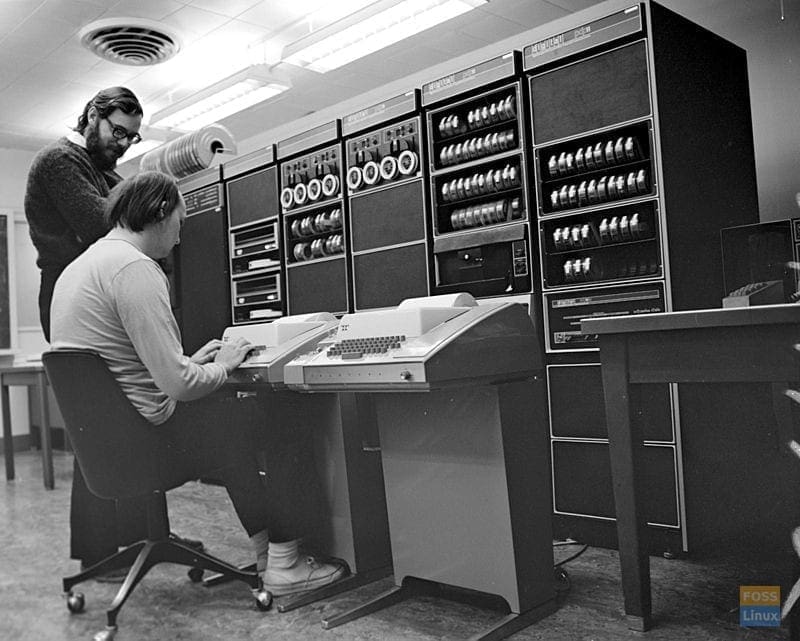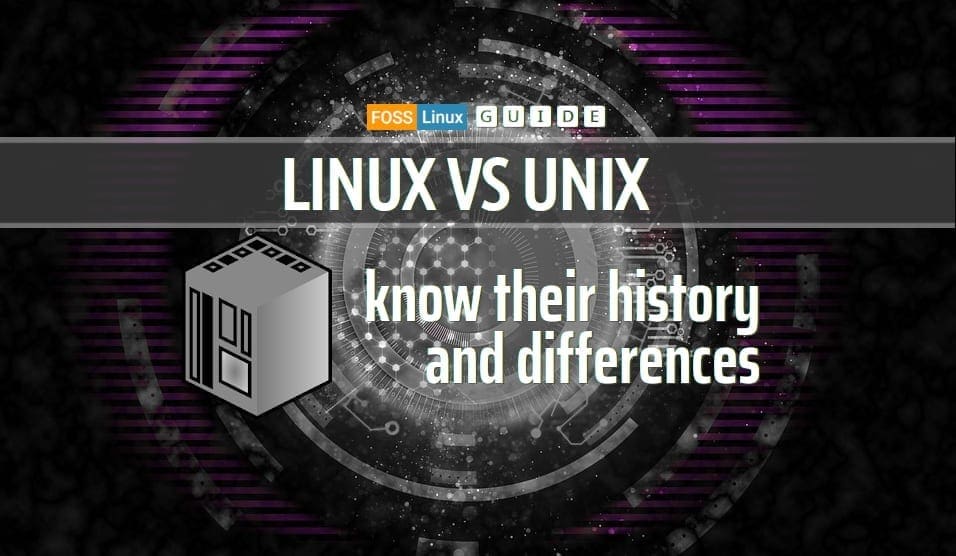When discussing Linux and Unix with average users, it’s not uncommon that they will sometimes mistakenly interchange the terms Linux and Unix. The two are not the same. Though they share similarities in their overall structures and toolkits, they are decidedly not the same.
Linux is a descendant of Unix, but it is not Unix. The approach and the philosophy behind Linux are entirely different from Unix. But to fully understand their differences, we must explore what each operating system is and the history of each.
What is Unix?
Unix began with a small team of programmers, most notably Ken Thompson and Dennis Ritchie, in the late 1960s at AT&T Bell Labs. Tasked with writing a multi-user, multi-tasking operating system for the PDP-7, the first iteration of what would become Unix was Multics and coded primarily in assembly language.

Ken Thompson and Dennis Ritchie (standing), part of the original Unix development team, at work on a PDP-11
In the early 1970s, the team rewrote the operating system in the C programming language. It was this decision that separated Unix from the few other operating systems available. Operating systems hereto were coded in low-level programming languages like assembly that tightly linked them to and made them dependant upon the hardware platform they were developed for. By rewriting Unix in the C programming language, Unix, no longer hardware-dependent, was now portable and could be transported to different hardware platforms.
This portability led to a rapid expansion of Unix, far beyond AT&T Labs, and it was soon the de facto standard for academic, research, and commercial users. The philosophy of Unix, coding small, independent, purpose-built programs to work in combination to complete complex overall tasks, also proved attractive to both programmers and users. Within just a few short years, Unix was the “big boy” on the block.
What is Linux?
What we know as Linux today is the culmination of two separate efforts from the 1990s. Richard Stallman, a programmer at the MIT Artificial Intelligence Laboratory, wanted to create a free and open-source alternative to Unix. He began building a library of programs and utilities. He dubbed GNU (GNU is not Unix!). However, although the applications and utilities were flowing and were impressive, GNU was not a real operating system as he did not have a kernel to go with his GNU. Enter Linus Torvalds, a student at the University of Helsinki.
The licensing of his university’s OS of choice, Minix (Unix’s precursor), frustrated Torvald. Minix, at that time, was limited to educational use only. Undeterred, Torvald began work on his OS kernel, using the Unix-like Minix kernel as his model. That kernel eventually became the Linux kernel.
The marriage of Stallman’s GNU toolset and Torvalds’ Linux kernel was a custom-made match that resulted in a viable free and open-source alternative to the proprietary Unix OS and associated programs and utilities. As a result, GNU/Linux (usually just referred to as Linux) was born.
The Linux kernel would have been of little value without GNU, and likewise, the Linux kernel without GNU.
Early popular distributions of GNU/Linux like Red Hat and Slackware afforded old 1990 PC users alternatives to the much-maligned, often-despised Windows OSs. Also, because GNU/Linux is free and open-source, interested Linux enthusiasts could (and can) create their own Linux distributions because Linux and its components are free and open-source. And build they did and do. There are currently over 275 different Linux distributions available for free download. Popular distros like Fedora, Ubuntu, Manjaro, Linux Mint, and others keep my fellow writers and me at FOSS Linux busy providing news, tips, and how-to articles to our readers.
The popularity of Linux and the FOSS concept continues to grow, too. Even Microsoft, once a sworn enemy, has now embraced Linux and the open-source concept. Google uses the Linux kernel for both Android and Chrome OS, and many other Linux-based projects are on the market and in development, such as IBMs LinuxONE and mainframes. These are customized to run Linux and open-source software. Even the Librem 5 Phone, and Mythbuntu, the special edition of Ubuntu that includes the MythTV media center software run on Linux.
What are the differences between Unix and Linux?
So we know that Linux is “Unix-like” but is not Unix. What are the differences? Hopefully, this table helps to illuminate the many and striking differences between Unix and Linux.
| Premise of Difference | Linux | Unix |
|---|---|---|
| Orgin | Original code developed by the GNU Foundation and Linus Torvalds. | Original code developed by AT&T Bell Labs. |
| Cost | Linux is free and freely distributed. Paid versions exist, also. | Different flavors of Unix is available at a cost dependent on the vendor and Unix variant. |
| Source Model | Open-source. Its source code is available publically. | Unix is traditionally closed-source, but some open-source Unix projects now exist like illumos OS and BSD. |
| Text Interface | Bash is Linux's default shell. However, it can support multiple command interpreters. | The Bourne shell originally, However, now other's such as Bash, Korn, and C can be used. |
| GUI | Originally just KDE and Gnome, but now alternatives like Xfce, Mate, Unity, etc. are available. | Unix was initially only command-based OS. Later a GUI, Common Desktop Environment was created. Now most variants ship with Gnome. |
| Processor/Architecture | Linux was originally developed for x86 hardware. Now, however, ports are available dozens of CPU types. | PA-RISC and Itanium machines, but some UNIX variants are available for x86/x64 based systems, PowerPC, and others. |
| Architecture | ||
| Versions | Versions in Linux are known as distros. There are hundreds. Fedora, Red Hat, Suse, and Manjaro are but a few. | Versions in Linux are known as variants. SCO-Unix, HP-UX, AIX, OS X, Solaris are a few popular ones. |
| Supported File Types | Ext2, Ext3, Ext4, Jfs, ReiserFS, Xfs, Btrfs, FAT, FAT32, NTFS | jfs, gpfs, hfs, hfs+, ufs, xfs, zfs |
| Official Website | www.kernel.org | opengroup.org/unix |
Conclusion
Unix and Linux share many similarities such as the CLI and GUI interfaces, a POSIX interface, various development tools like Perl, PHP, and Python, shells, and various office applications like OpenOffice.org. Despite these similarities, they are not the same. We’ve covered both OSs histories along with their similarities and differences.
However, Linux users and aficionados need to note that without Unix, there would be no Linux. The younger OS owes a debt of gratitude to its “father” OS. However, Linux is a “grown” OS now, a self-sustaining operating system with hundreds of different distributions vital in making the modern world run. From PC and laptop operating systems to cellphones to websites, Linux makes possible much of what we do in our daily life.
So, the next time that you install a new or different Linux distro, make a call on your smartphone or even pay your electricity bill online at your provider’s website, thank Linux, but don’t forget to appreciate its “dad,” Unix, too.



